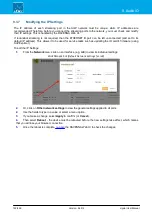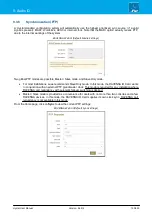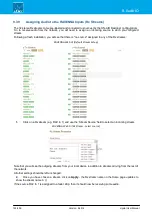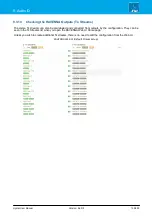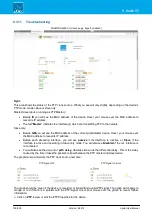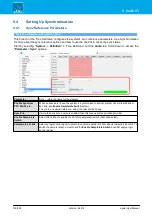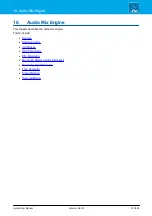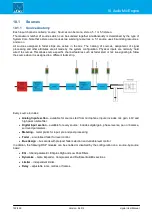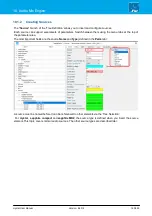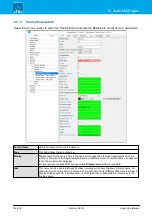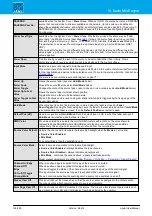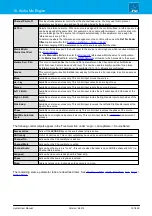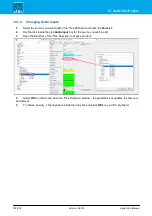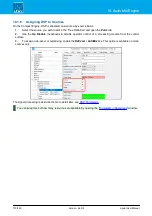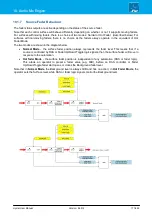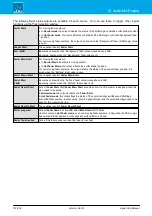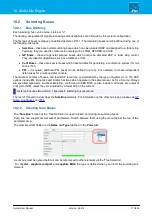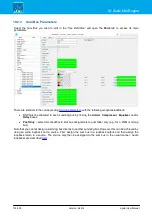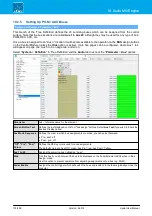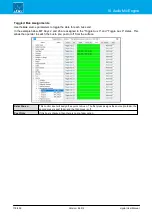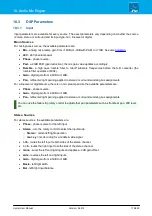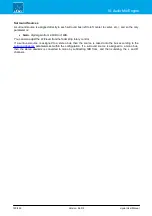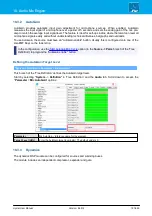
crystal User Manual
Version: 6.6.0/2
166/459
10. Audio Mix Engine
RAVENNA
RAVENNA Pool No.
Available when the System Core =
Power Core
. When set to ON, the source becomes a RAVENNA
source that can subscribe to streams available on the network. Up to 6 pools can be defined to
shape the availability of streams, and whether a particular stream can be selected by this source. A
RAVENNA Src Pool element must be defined to support this feature. See Configuring RAVENNA
Pool Sources.
Fader Level Sync
Available when the System Core =
Power Core
. This feature works in the same way as "Fader
Level Sync" in a Minimix Source (described
). It allows the source fader level to be controlled
from another gain element (e.g. Source, VCA, GNET UDP). Similarly, the
Fader Level Out
(in the
'Tree Selection') can be used to control gain in another element (e.g. Source, Minimixer, GNET
UDP).
When using this feature to sync different control types, note that there may be differences in the
value ranges: e.g. Faders = infinity to +9dB; VCAs = infinity to 0dB. In this instance, the effective gain
value is applied.
Fader Open
Tick this box if you wish the level of the source to be set to 0dB rather than - infinity. This is
particularly useful for sources which are not to be assigned to the control surface.
Input Mute
Selects an input control signal to mute the audio input.
This mute occurs at the point before the signal is distributed in the matrix, therefore will affect routes
to other destinations as well as to the selected source. (To mute the source within the ‘channel’, see
.)
The mute is active until the input control signal = Logical “1”.
Fader Up
Fader Down
Fader Toggle
Fader Up to Last
Value
Fader Toggle to Last
Value
Opens the source fader (see also
Hold Mode
below).
Closes the source fader (see also
Hold Mode
below).
Changes the state of the source fader: open to closed, or vice versa (see also
Hold Mode
below)
.
Opens the source fader to its last known position.
Toggles the source fader to its last known state.
These 5 functions can be used to program a fader start and are triggered by the rising edge of the
input control signal.
Hold Mode
When this input is active, the last position is stored when the fader is closed by
Fader
Down
/
Toggle
. Opening the fader using logic sets the fader to the last stored position. If
Hold Mode
is activated while the fader is closed, then the
Default Position
set below is used.
Default Pos (dB)
Used in conjunction with
Hold Mode
. Sets the default level, in dB, to which the fader will open if
Hold Mode
is activated while the fader is closed.
DMS Color
The value entered here selects the color for DMS meters within VisTool. The value shown is
represented by 0xRRGGBB where RRGGBB denote the amounts of Red, Green and Blue
respectively. Click on the color selector box to choose from the color palette.
Source Color Default
Selects the color used to illuminate the fader strip backlight when the
Mode
is set to either:
·
Source Color Enabled
·
Mix Mode
If you select Black, then the backlight is unlit.
Source Color Mode
Select the mode of operation for the
fader strip backlight:
·
Source Color Enabled
- always indicates the type of source.
·
Source Color Disabled
- always indicates signal present.
·
Mix Mode
- combines the options above; signal present takes priority.
Signal present parameters are defined under "
System -> Definition -> Parameter = Signal Present
".
Channel On Edge
Channel Off
Edge
Ch On/Off Toggle
Channel Mute
When a positive edge is supplied to this input, the source is unmuted.
When a positive edge is supplied to this input, the source is muted.
This input toggles the status of the channel mute on each rising edge of the control signal.
This input mutes the source as long as it is supplied with an active control signal.
These 4 control inputs allow the audio signal of a source to be switched on and off.
Access User Off
This input locks out the Access Key so that the source cannot be assigned to the center section.
You may use this to limit operator access to source parameters.
Parm Page User Off
This input locks out all DSP modules for the source. You may use this to prevent parameters such
as a presenter’s mic EQ and Compression from being altered by the operator.

